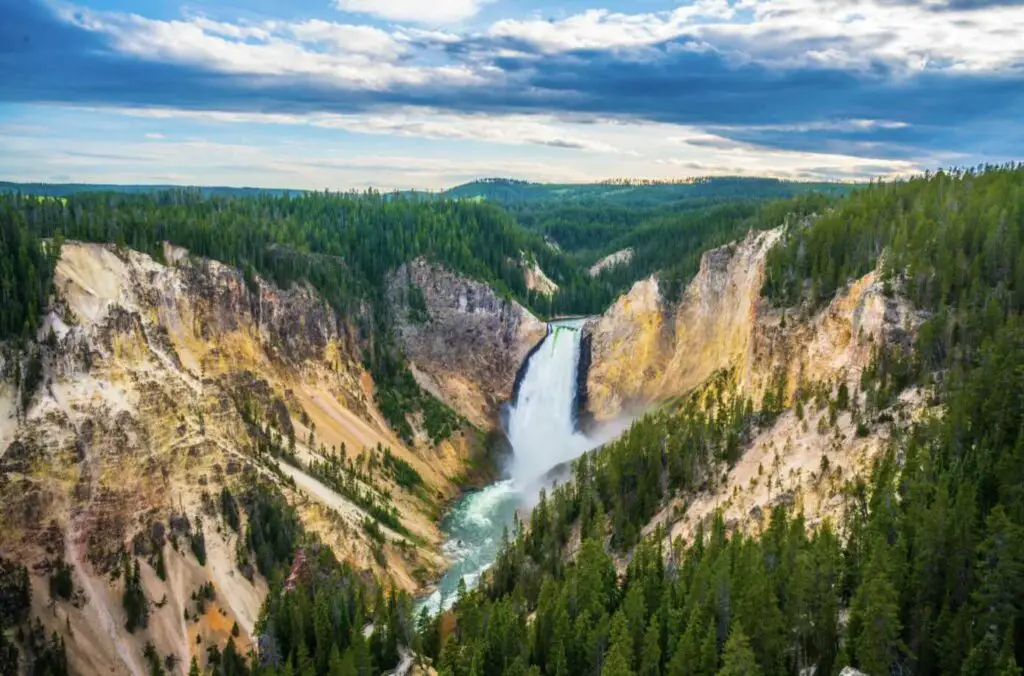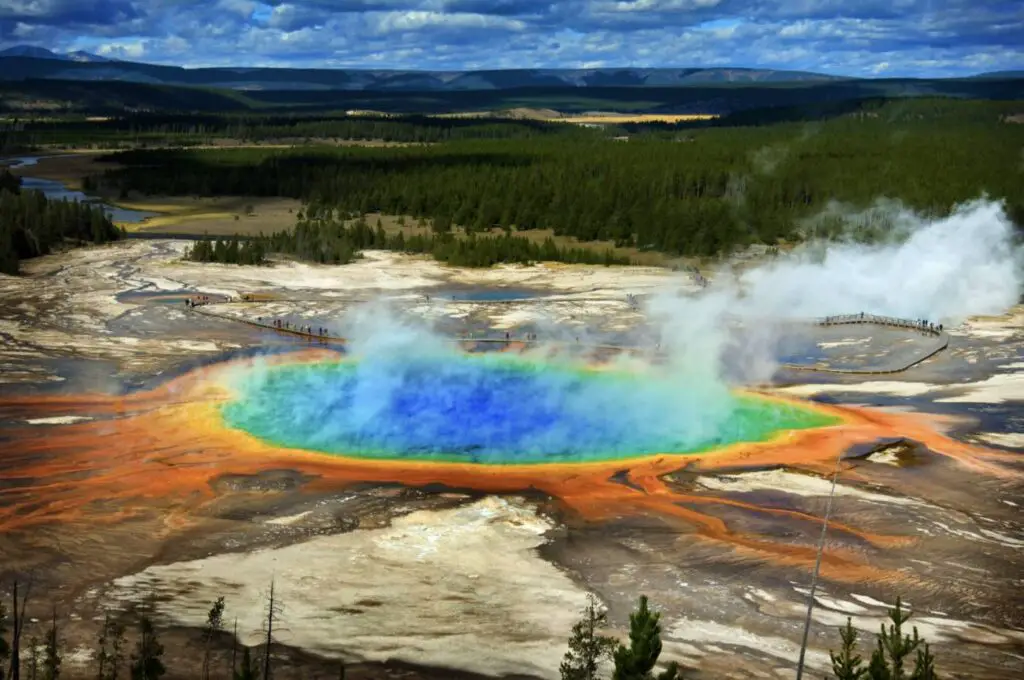Yellowstone National Park’s story of becoming the cornerstone of American conservation is a tapestry of discovery, advocacy, and visionary legislation. From its early days of enchantment and mystery to its present status as a beacon for environmental preservation,
Yellowstone’s tale is one of humanity’s increasing respect and reverence for the natural world. This narrative highlights the park’s unparalleled beauty and ecological importance and signifies a pivotal shift in our collective approach to protecting such extraordinary landscapes for all time.
Table of Contents
- The Establishment of Yellowstone National Park
- Ecological and Cultural Significance
- Yellowstone’s Influence on National and Global Conservation
- Related Questions
The Establishment of Yellowstone National Park
Yellowstone’s journey to becoming America’s first national park is a story of awe, advocacy, and good timing. Before it was a household name, Yellowstone was largely unexplored, and its landscapes were more myth than documented reality. This changed in the late 19th century when expeditions ventured into these wild lands, revealing wonders that would capture the nation’s imagination.
In 1870, the Washburn-Langford-Doane Expedition took the crucial step of comprehensively exploring the Yellowstone area. They encountered geysers throwing boiling water into the sky, vast canyons painting the landscape with hues of orange and red, and hot springs with vivid colors that seemed almost unearthly. These discoveries were remarkable, surpassing the tales that had trickled back to the eastern United States.
The concept of preserving such a place was revolutionary. At the time, land was seen as a resource to be used, whether for mining, logging, or settlement. Setting aside a significant expanse of land purely for its natural beauty and public enjoyment was unheard of.
The pivotal push towards protection came from the expedition members, notably Ferdinand V. Hayden. Following their explorations, Hayden led a geological survey in 1871 and produced a comprehensive report that included stunning photographs by William Henry Jackson and detailed illustrations by Thomas Moran. These visuals were instrumental in conveying Yellowstone’s wonders to a broader audience, including the U.S. Congress.
Influential lawmakers and conservationists began to advocate for preserving Yellowstone. They realized that this untouched wilderness could be exploited commercially without formal protection. This sense of urgency spurred legislative action.
On March 1, 1872, President Ulysses S. Grant signed the Yellowstone National Park Protection Act into law, establishing Yellowstone as the world’s first national park. This ground-breaking legislation set aside more than 2 million acres for “the benefit and enjoyment of the people.”
It began a global national park movement, reflecting a bold idea: natural treasures should be preserved unimpaired for future generations.
The establishment of Yellowstone as a national park laid the foundation for the conservation ethic that would eventually create an entire system of national parks and protected areas worldwide. It underscored the importance of preserving natural beauty and biodiversity for its own sake, a concept that was revolutionary at the time and remains essential today.

Ecological and Cultural Significance
Yellowstone National Park, nestled in the western United States, stands as a testament to the magnificence and complexity of nature. Its designation as the first national park in 1872 signaled a profound shift in how societies value and interact with the natural world.
However, Yellowstone’s significance extends far beyond its pioneering status in conservation. The park is an ecological wonder, boasting a mosaic of ecosystems that are a sanctuary for a wide variety of wildlife. It is also a cultural cornerstone that reflects centuries of human history intertwined with the natural landscape.
Delving into the ecological aspects, Yellowstone is essentially a living laboratory. Scientists flock to the park to study its geothermal features, wildlife, and ecosystems, which are relatively undisturbed by human intervention.
The park is home to one of the last intact temperate zone ecosystems where you can find a complete array of native large mammals, including grizzly bears, wolves, and herds of bison and elk. This is rare in the modern world and offers invaluable insights into natural predator-prey dynamics, genetics, and conservation strategies.
The geothermal features, like the iconic Old Faithful geyser, hot springs, and mud pots, are surface expressions of the immense volcanic forces that shape the landscape, providing a window into Earth’s dynamic geologic processes.
Culturally, Yellowstone is a rich tapestry woven from the narratives of Native American tribes, explorers, conservationists, and tourists. For thousands of years, multiple Native American tribes have viewed the park’s lands as sacred, valued for their abundant resources and spiritual significance.
These lands tell stories of human interaction with the environment, conflicts, and the evolution of societal values toward conservation. The establishment of Yellowstone as a national park marked a seminal moment in human history, reflecting a growing consciousness about the importance of preserving natural wonders for future generations. This value has spread globally, influencing conservation efforts worldwide.
Further, Yellowstone’s cultural treasure is manifested through its influence on art, literature, and photography. Many artists and writers have drawn inspiration from the sublime beauty of the park’s landscapes, contributing to a cultural phenomenon that romanticizes the American West and underscores the importance of wilderness in the human psyche. Yellowstone’s awe-inspiring vistas continue to capture millions’ imaginations as a muse for creativity and a source of rejuvenation for the spirit.
The interplay between Yellowstone’s ecological intricacies and cultural resonance underscores its standing as an invaluable treasure. It reminds us of the intrinsic value of wilderness areas, not only for their ecological services and biodiversity but also for their capacity to inspire, teach, and connect us to the natural world.
Yellowstone’s enduring appeal lies in its ability to transcend the ordinary, offering a refuge that is both an ecological marvel and a wellspring of cultural enrichment. As we move forward, it remains a beacon of conservation, a testament to the foresight of those who sought to preserve such a magnificent landscape and a continuous challenge to balance human activity with the imperative to protect the natural world.

Yellowstone’s Influence on National and Global Conservation
Yellowstone National Park, sprawling across Wyoming, Montana, and Idaho, is not just a haven for wildlife and geothermal wonders; it stands as a cornerstone in the narrative of global conservation. Since its establishment in 1872, this iconic park has ignited a worldwide movement toward preserving the natural world, serving as a blueprint and inspiration for creating protected areas across the globe.
At the heart of Yellowstone’s influence is its pioneering status as the first national park in the world. This groundbreaking moment marked a pivotal shift in human perspective, acknowledging the intrinsic value of nature and the necessity of safeguarding it for future generations.
The idea that a nation could set aside a vast and scenic area, not for kings or the elite but for the public good and the enjoyment of people worldwide, was revolutionary. This concept of conservation through national parks quickly caught the imagination of nations worldwide.
Following the example of Yellowstone, countries around the globe began establishing their protected areas. Canada inaugurated Banff National Park in 1885, Australia followed with the Royal National Park in 1879, and New Zealand with Tongariro National Park in 1887.
These early adopters recognized the wisdom in preserving their unique landscapes and biodiversity, a trend that has only accelerated over time. Today, thousands of national parks and protected areas are scattered across every continent, each owing a debt of gratitude to the pioneering efforts of those who fought to preserve Yellowstone.
Beyond its role as a global national park movement catalyst, Yellowstone has been a living laboratory for ecological and geological research. The park’s diverse ecosystems, which remain largely intact and bustling with the original flora and fauna, offer unparalleled opportunities for scientific study.
Yellowstone’s wolves reintroduced in the 1990s, have been a particularly compelling case study of how top predators can shape ecosystems. Such research enhances our understanding of natural processes and informs conservation strategies in other parts of the world.
Culturally, Yellowstone has captured the imagination of people worldwide. Its geysers, hot springs, and majestic wildlife have made it a symbol of the American wilderness, celebrated in art, literature, and photography. This cultural significance has played a crucial role in popularizing the concept of wilderness protection and fostering a deeper appreciation for the natural world among the public.
Furthermore, Yellowstone set the stage for the conservation discourse to evolve, incorporating broader environmental concerns and recognizing the interconnectedness of ecosystems. The park has been instrumental in discussions about climate change, habitat destruction, and species extinction, as a stark reminder of what’s at stake if we fail to act.
In balancing the demands of tourism and conservation, Yellowstone also presents an ongoing case study in managing human impact on natural landscapes. Efforts to minimize the footprint of the park’s millions of visitors each year while maintaining natural habitats and ensuring species’ survival reflect the broader challenges protected areas worldwide face.
In conclusion, Yellowstone National Park has been much more than a sanctuary for wildlife and a haven for geothermal wonders. Its establishment sparked a global conservation movement, inspiring the creation of national parks worldwide. Through its years of scientific research, cultural significance, and efforts to balance human activity with nature protection, Yellowstone continues to shape national and global conservation efforts, offering lessons in the enduring value and challenges of preserving the natural world.

As Yellowstone National Park continues to fascinate and inspire, its legacy goes beyond protecting geysers, wildlife, and breathtaking vistas. The park is a testament to the power and importance of conservation, reminding us of our responsibility to safeguard our planet’s wonders.
Yellowstone’s enduring influence on global conservation efforts underscores a profound commitment to the natural world, proving that vision and action can preserve our environment’s magnificence for future generations. The story of Yellowstone, therefore, is not just about the past; it’s about our ongoing commitment to the future of all-natural treasures on Earth.
At A Bus On A Dusty Road, we talk about travel, life, and ex-pat living. We are all about “Living Life As A Global Citizen.” We explore social, cultural, and economic issues and travel.
We would love to have you be part of our community. Sign up for our newsletter to keep up-to-date by clicking here. If you have any questions, you can contact me, Anita, by clicking here.
Listen to our Podcast called Dusty Roads. You can find it on all major podcast platforms. Try out listening to one of our podcasts by clicking here.
Subscribe to our A Bus On A Dusty Road YouTube Channel with great videos and information by clicking here.
Related Questions
Which Airport Is Close To Yellowstone? And Other Yellowstone Airport Travel Facts
West Yellowstone Airport is the closest airport to Yellowstone National Park. The airport is only a few miles from the park entrance but has a limited flight schedule and is not open all year round. Other airports include Jackson Hole Airport and Bozeman Yellowstone International Airport; both offer more flights, car rental, and ground transportation options.
By clicking here, you can discover Which Airport Is Close To Yellowstone? And Other Yellowstone Airport Travel Facts.
Is Yogi Bears Jellystone Park Based On Yellowstone Park?
Yogi bear’s Jellystone is known to be based on Yellowstone National Park, even though it is supposed to represent all U.S. National Parks. Yogi Bear is a fictional cartoon character that has been around since 1958 but has recently seen some reemergence with a new Yogi Bear Movie (2010) and Jellystone Cartoon series (2021).
By clicking here, you can discover Is Yogi Bears Jellystone Park, Based On Yellowstone Park?.
What Happened To The Black Wolf At Yellowstone?
The Black wolves at Yellowstone are still part of the Yellowstone National Park. In Yellowstone, 505 of the wolves are black; the black color is not native to most wolf populations.
By clicking here, you can discover What Happened To The Black Wolf At Yellowstone?

